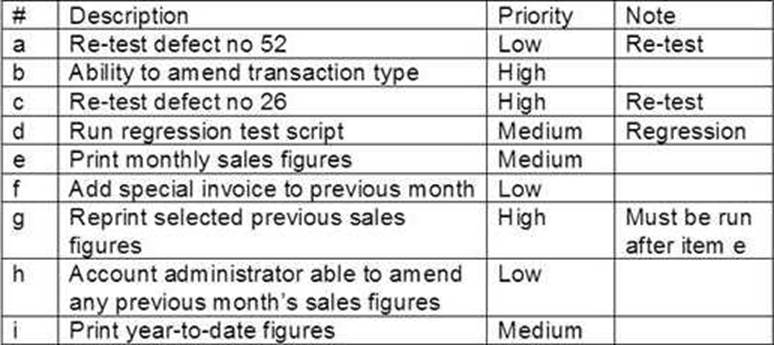- All Exams Instant Download
Which of the following gives an appropriate test execution schedule, taking account of the prioritisation and other constraints?
Refer to the exhibit
The following test cases need to be run, but time is limited, and it is possible that not all will be completed before the end of the test window

The first activity is to run any re-tests, followed by the regression test script. Users have supplied their priority order to tests.
Which of the following gives an appropriate test execution schedule, taking account of the prioritisation and other constraints? [K3]
A . b, c, g, d, e, i, a, f, h
B . a, c, d, b, g, e, i, f, h
C . c, a, d, b, e, g, i, h, f
D . d, c, a, e, b, g, i, f, h
Answer: C
Explanation:
The test execution schedule should take into account the prioritization and other constraints given in the question. The first activity is to run any re-tests, followed by the regression test script. Users have supplied their priority order to tests. Therefore, the test execution schedule should start with the re-test defect no 52, which is shown in the image as a table with 9 rows and 4 columns. The table is titled “Re-test defect no 52”. The columns are labeled: “#”, “Description”, “Priority”, “Note”, “Re-test”. The table is populated with data about different tasks and their priority and notes. The tasks are related to sales figures and account administration. The table is in black and white. The re-test defect no 52 has three tasks: c, a, and d, which have priority 1, 2, and 3 respectively. Therefore, the test execution schedule should start with c, followed by a, and then d. After that, the regression test script should be run, which is task e. Then, the remaining tasks should be run according to the user priority order: b, g, i, h, and f. Therefore, the test execution schedule is c, a, d, e, b, g, i, h, and f.
Latest CTFL_Syll2018 Dumps Valid Version with 314 Q&As
Latest And Valid Q&A | Instant Download | Once Fail, Full Refund
Subscribe
Login
0 Comments
Inline Feedbacks
View all comments

